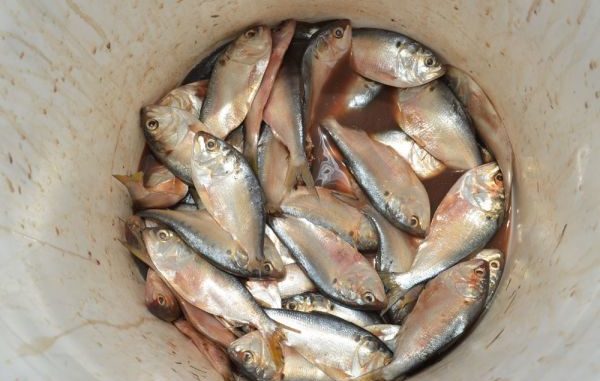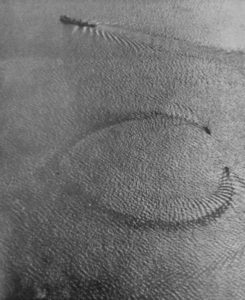
Industry is close to perfect fishery
Yes, everybody eats pogies; They just don’t know it.
The sea is a funny place. On land, planting-eating species (herbivores) vastly outnumber meat-eaters (carnivores). That’s because it takes 10 pounds of herbivore flesh to produce 1 pound of carnivore.
In the sea, it seems like every fish eats another fish — they are all carnivores. Or almost all. At the bottom of the fish food chain sits the menhaden, commonly called the pogie. Almost every fish that we humans love to catch and eat in turn eats pogies, so we humans are essentially eating “re-manufactured pogies.”
Pogies numbers are awe-inspiring — in the many, many millions. They swim in massive, silvery schools that attract many predator species, including man.
The menhaden purse seine fishery, just by the sheer size of its catch and the size of its fishing equipment, sometimes catches the jaundiced eye of a recreational fisherman who worries about the nets catching all of his favorite fishes’ food.
Some biologists, though, have called the Gulf of Mexico menhaden fishery a near-perfect fishery. Factors of such a perfect commercial fishery would include:
• Low bycatch.
• A stable number of fishermen, without the big swings in numbers that often occur in commercial fisheries.
• The fishery would not be in competition with recreational fishermen for the fish.
• The number of fishermen in the fishery would be small enough to monitor their catch accurately.
• All parts of the fish would be used, with no backbones, skin, shells or other waste to discard.
• The fishery would be consistently profitable.

The most-difficult goal of these six elements to meet has been the last one — profitability — although recent years have been good to the fishery.
The primary target of the fishery is the gulf menhaden, Brevoortia patronus, found between Orange Beach, Ala., and Freeport, Texas.
Some yellowfin menhaden, B. smithi, are caught on the eastern end of the fishery and some finescale menhaden, B. gunteri, are caught on the western end. Off of Louisiana, some net sets are also made on thread herring, Opisthonema oglinum.
Menhaden are caught with a large purse seine, but located by the pilot of a small spotter airplane.
The fishery is the largest by weight in the Gulf, averaging 1.1 billion pounds per year. Almost all of that catch is reduced into fish oil, meal and solubles.
Many studies have been done on bycatch in the fishery, showing it ranges from 0.06 to 3.9 percent by number and 1 to 2.8 percent by weight.
In every study, croakers ranked first or second as the most common bycatch. Other bycatch species include striped mullet, spot, gafftopsail and hardhead catfishes, threadfin shad, sand and silver seatrout, and Atlantic bumper.
Very few speckled trout or redfish are found in menhaden fishery bycatch.
Menhaden catches are closely monitored. The menhaden companies provide catch records and the captain’s daily fishing reports directly to the National Marine Fisheries Service. Port agents with NMFS also regularly take dock-side samples of menhaden catches.
Size and age data from these samples are used, along with catch records, to assess the health of the menhaden stock.
At the dock, menhaden catches are unloaded from carrier vessels using pumps that move the fish directly into a steam cooker.
The fish are moved to a press that squeezes oil and water from the fish, leaving what is known as “press cake.” This press cake is dried, and ground into meal and treated for storage.
The oil and water is pumped through screens and filtered to remove particles that are added back to the press cake before it is dried.
Oil is separated from the water and purified for storage or shipment.
The water, called “stickwater” — with its remaining dissolved solids — is reduced in volume by an evaporator. Some of this concentrated liquid is added back to the press cake. Fish meal that has stickwater added is called “whole meal” or “full meal.
Stickwater not used for this process is concentrated to a 50-percent solid content and treated for storage as condensed fish solubles.
Menhaden meal has a minimum of 60 percent protein and a well-balanced amino acid profile. It is a valuable animal feed.
Feeds for aquacultured fish may contain up to 20 percent fish meal. It is also used in feeds for baby swine. Large quantities are also used in high-end, all-natural dog food.
The largest consumer of fish meal is China, where it is used in fish and swine culture. Because of these exports, the fishery provides jobs in the United States funded with dollars imported from other countries.
Almost all of the fish oil produced is exported to Europe and Canada for use as aquacultured salmon feed, although some is used in Idaho rainbow trout farms.
Most of the rest that is used domestically goes into pharmaceutical and over-the-counter fish oil capsules. Although the use of menhaden oil in human foods, such as margarine and cooking oils was approved in the U.S. in 1997, no Gulf of Mexico menhaden oil presently goes to making these products.
Solubles that are not put back into meal products are used as natural fertilizers in places like golf courses or plant nurseries.
Gulf menhaden are generally considered to provide a well-managed fishery. A stock assessment is due to be released on the health of the fishery within a year.


